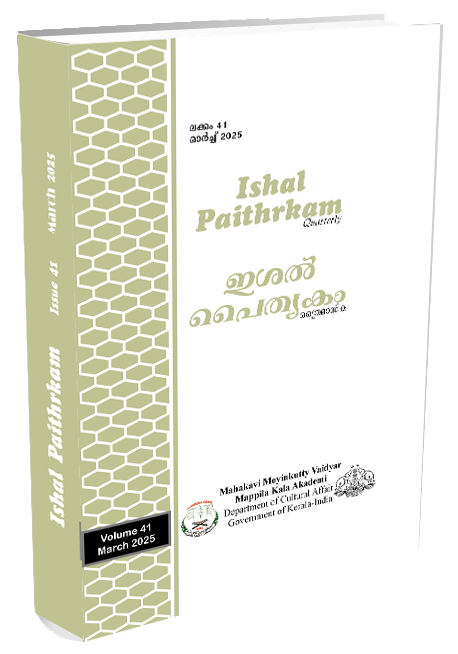Reconfiguring the Marginality of Disability in Nazi Euthanasia: A Study of Countermemory Narratives of Yuko Tsushima’s Karino Jidai and Ann Clare LeZotte’s T4: a Novel in Verse
Keywords:
Holocaust narrative, Memory, Disability, Euthanasia, ProsthesisAbstract
The historical and political significance underlying the narratives of the disabled victims has remained largely unacknowledged since the marginal position occupied by the victims within the mainstream popular understanding of the Holocaust has been undermined. Moreover, the act of legitimizing the survivor testimonies has resulted in the de facto marginalization of their memories within the discourse of Holocaust and Memory Studies. The study attempts to interrogate the post war memory cultures of the Nazi euthanasia in Ann Clare LeZotte’s T4: a Novel in Verse and Yuko Tsushima’s Karino Jidai. It examines the historical uncanny and the unheimlich felt in the memory cultures of Nazi euthanasia. It also studies the various memory cultures of disabled victims, drawing on Kaja Silverman’s concept of heteropathic recollection and Hannah Arendt’s notion of compassion in order to resist the appropriation of their memories. It incorporates the methodology of narrative prosthesis and aesthetic nervousness as a means of reading the narratives of disability and underscore the conflicts and crises of representation of disability. The diverse representational strategies of reading the disabled bodies emphasizes the role of body in literature as a liminal point in the representational process.
References
Agamben, G. (1998). Homo sacer: Sovereign power and Bare Life. Stanford University Press.
Agnew, V., Tomann, J., & Stach, S. (Eds.). (2023). Reenactment Case Studies: Global Perspectives on Experiential History. Routledge.
Aguilar, Catalina Devandas. (2019). Bioethics and Disability: report for UN Special Rapporteur on Disability. United Nations: Geneva. https://www.ohchr.org/en/special-procedures/sr-disability.
Albrecht, K. (2002). Organizational intelligence and Knowledge management the executive
perspective. Retrieved, 2006, From. http://www.karl Albrecht.com
Arendt, Hannah. (1990). On Revolution. London: Penguin.
Bauman, H-Dirksen L., and Joseph J. Murray. (2014). Deaf Gain: Raising the Stakes for Human Diversity. University of Minnesota Press.
Bérubé, Michael. (2005). Disability and Narrative. PMLA. 120.2: 568–76.
Bérubé, M. (1996). Life as we know it: A father, a family, and an exceptional child. New York, NY: Pantheon.
Bhabha, Homi K. (1994). The Location of Culture. New York: Routledge.
Davis, Lennard J., ed. (2006). The Disability Studies Reader. 2nd ed. New York: Routledge.
Felman, Shoshana, and Dori Laub. (1992). Testimony: Crises of Witnessing in Literature, Psychoanalysis, and History. New York: Routledge.
Foucault, M. (1961). Madness and Civilization. Pantheon Books.
Freud, S. (1919). Das Unheimliche. The Uncanny.
Hirsch, Marianne (2008). The Generation of Postmemory. Poetics Today. 29.1: 103–28.
——— (1999). Projected Memory: Holocaust Photographs in Personal and Public Fantasy. Acts of Memory: Cultural Recall in the Present. Ed. Mieke Bal, Jonathan Crewe and Leo Spitzer. Hanover: UP of New England.
Knittel, Susanne. (2012) Beyond Testimony: Nazi Euthanasia and the Field of Memory Studies. Holocaust in History and Memory. 5: 85–101.
———.(2010). Bridging the Silence: Towards a Literary Memory of (Nazi) Euthanasia. Edinburgh German Yearbook. 4: 124–33.
LaCapra, Dominick. (2001). Writing History, Writing Trauma. Baltimore: Johns Hopkins UP, Parallax.
LeZotte, Ann Clare. (2008). T4: A Novel in Verse. Houghton Mifflin Co.
Mitchell, David T., and Sharon L. Snyder. (2006). Cultural Locations of Disability. Chicago: U of Chicago P.
——— 2000.). Narrative Prosthesis: Disability and the Dependencies of Discourse. Ann Arbor: U of Michigan P.
Nora, Pierre. (1989). Between Memory and History: Les Lieux de Mémoire. Trans. Marc Roudebush. Memory and Counter-Memory. Spec. issue of Representations 26: 7–24.
Rothberg, Michael. (2010) Between Memory and Memory: From Lieux de mémoire to Noeuds de mémoire. Noeuds de mémoire: Multidirectional Memory in Postwar French and Francophone Culture. Spec. issue of Yale French Studies 118–19: 3–12.
——— (2009). Multidirectional Memory: Remembering the Holocaust in the Age of Decolonization. Stanford: Stanford UP.
Peterson, Erica Lyn. Disabilities of Fiction: Reading Madness in Twentieth-Century American Women's Literature, dissertation, May 2024; Denton, Texas. (https://digital.library.unt.edu/ark:/67531/metadc2332538/m1/135/: accessed September 20, 2024), University of North Texas Libraries, UNT Digital Library, https://digital.library.unt.edu;.
Stokoe, William C. (1991). Semantic phonology. Sign Language Studies 71: 99–106.
Thomson, R. G. (1997). Extraordinary bodies: Figuring physical disability in American culture and literature. Columbia University Press.
Y. Tsushima. (2016). Karino Jidai [The Age of Hunting]. Tokyo: Bungeishunju.
Downloads
Published
Issue
Section
License
Copyright (c) 2025 ISHAL PAITHRKAM

This work is licensed under a Creative Commons Attribution-NoDerivatives 4.0 International License.

